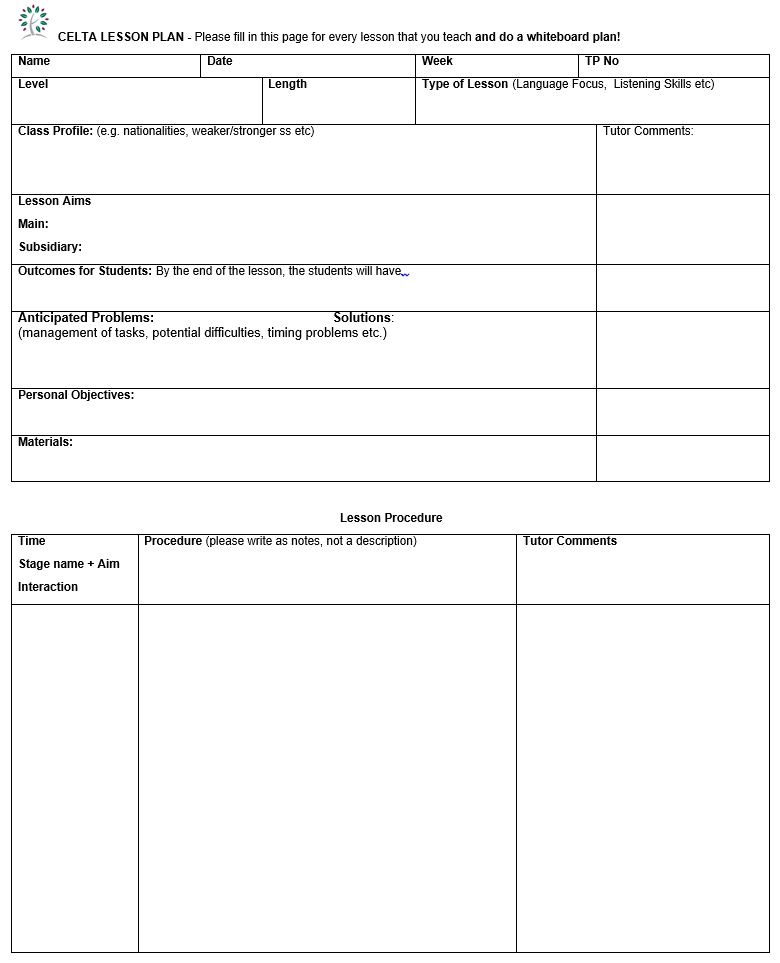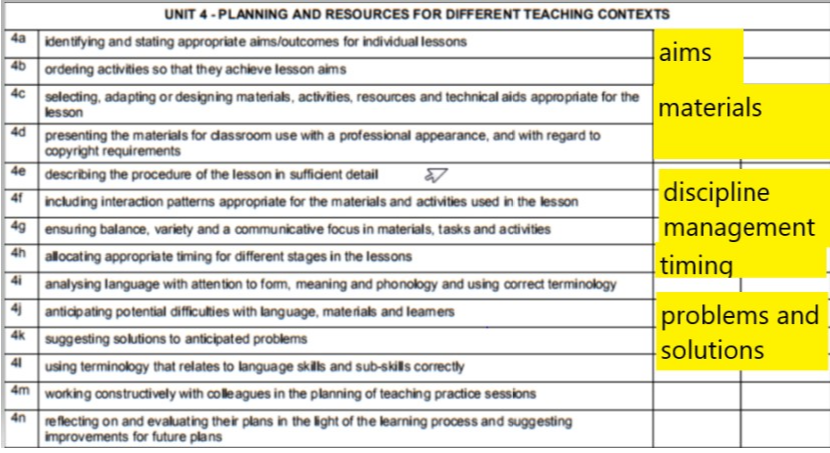“Lesson planning, plan the lesson”. These are the instructions you will hear throughout the course. A lot of discussions, debates, and success stories are witnessed during the training. For me, this was one of the most emotional parts of the course. I wish I had read and prepared more for this part.
I remember the first lesson I had to plan and teach. I was absolutely confident that I would do a big thing. No, no. It was not the way I expected. My trainer asked me to forget about my experience and only focus on the criteria and standards that CELTA has for the lesson planning.
So, let’s look at it more attentively and seriously.
Here is a lesson plan template that you will have to use in the course.

Let’s look at it, and we will see that we need to write objectives, problems, describe the materials and the procedure.
Objectives and lesson aims
You should be aware of the difference between aims and objectives. When we state aims, we bear in mind that this is what we hope to teach, while objectives assume what the students will be able to do after the lesson; what skills or knowledge they will have acquired by the end of the lesson.
We should not forget to make aims and objectives clear and specific. There should be no ambiguity here. Your success of the lesson will be based on how you have achieved the aims and objectives. That is why you should state them clearly and specifically.
Next, do not forget that aims and objectives should be achievable. Your learners should be able to complete the objective. It means you should know about their background knowledge, be aware of time restriction and ways to make sure the goal is reached.
Here is a hint for you; do not make lesson objectives too easy; your lesson dynamics will suffer.
And finally, you should make sure that the learners find the value in the material you are teaching. You should not teach anything that is useless or unimportant.
Anticipated problems
While planning a lesson, you should also think about the problems that may arise and the ways to handle them.
In general, problems can be categorized into three groups:
Language problems
Students may face issues with the language, such as pronunciation, native language interference etc. Some meanings can be challenging to grasp for a learner. Some people usually have the problem of grasping the meaning of modal verbs as in their native language there are few modal verbs. Others may have difficulty understanding the auxiliary verbs.
Technical problems
There can be problems with the equipment. For example, your laptop may be faulty, the audio that you planned may not work, the projector may not connect to the computer etc. You should think of plan B in case anything goes wrong with technology.
Problems with the procedure
As you should be able to demonstrate different activities in your lessons plans such as group work, pair work, and individual work. Some people may dominate in group work, others can step back and relax. Some students may feel uncomfortable to work with others. These are the issues you should record in your lesson plan to show that you scrupulously have planned the lesson.
Materials and resources
Look at the lesson plan template and see that you will have to list the materials or the resources you will be using at the lesson. You can surely use the course book to teach your lesson if all the students have them. You may need to find out whether the students are willing to share the coursebook to be able to think about activities that sharing will not cause any issues.
But I also recommend planning some handouts for your lesson. It will show that you have thoroughly prepared for your lesson.
Stages of the lesson plan
When you start planning the stages, you need to make sure that there is a logical link between the stages. Moreover, all the stages in your lesson plan should lead to achieving lesson aims.
When you plan every stage, ask yourself a question “why should my students do this? And how will this help me to reach the goals?”
Classically or traditionally, they use PPP (Presentation, Practice, Production) lesson plan. This type of lesson plan is easier to plan and implement. I also think this is a “safe” plan. The logic is there; first, you present a new topic, then your plan activities so that your students gain confidence and accuracy and finally, you give them freer practice to use the knowledge they acquired.
Each stage should be described with the procedure. Be specific in describing the procedure; this will not only help CELTA trainer to assess you but also it will make your life easier. It helped me a lot when I was planning my lessons during the CELTA course. You get to the training center after a sleepless night, a little stressed because you know your lesson and your lesson plan will be assessed. So when you have a detailed description of what you will be doing, it definitely reduced the stress.
Timing
You should not forget that timing is crucial in planning a lesson. Knowing your students and their skills, their dynamics and pace of work, you should be able to plan your lesson carefully. In case you cannot do that, have plan B, if things go faster or slower than you planned.
Classically or traditionally they use PPP (Presentation, Practice, Production) lesson plan. This type of lesson plan is easier to plan and implement. I also think this is a “safe” plan. The logic is there; first, you present a new topic, then your plan activities so that your students gain confidence and accuracy. Finally, you give them freer practice to use the knowledge they acquired.
In a nutshell, you will need to look at this grading criteria to be able to reflect on how you need to plan your lesson and what you need to focus on when planning it.

Also read: How to Create a Great Lesson Plan
Wish you all the best in your preparation for CELTA course. If you find this blog useful, please share it among those who plan to take CELTA.
This article was originally published in Aug-2019 and was last updated in Nov-2020.
Author: Lusine Stepanyan




